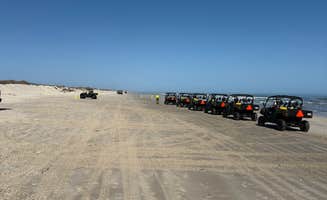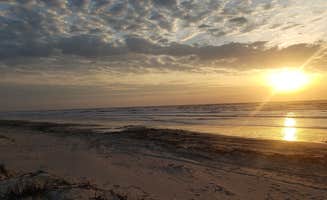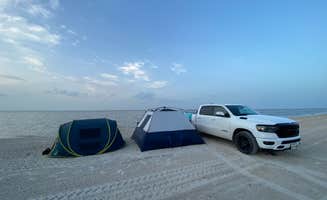Rustic camping near Rockport, Texas provides direct Gulf access with overnight options ranging from free to low-cost. The coastal zone maintains warm winter temperatures averaging 65°F with limited rainfall from November to February. Seasonal weather conditions significantly impact camping experiences, with consistent southeasterly winds affecting tent stability and campsite selection.
What to do
Fish directly from camp: At Padre Island South Beach, campers can fish without leaving their site. "I loved beach camping, plenty of space with 20 miles of beach front free camping! Can't beat this," reports one visitor.
Observe wildlife: Evening wildlife viewing rewards patient campers. "On some evenings after dark you can spot deer and coyote come out of the sand dunes to feed on seaweed and fish remains," notes a regular at South Beach — Padre Island National Seashore.
Kayaking in protected waters: The calm bay waters at Magnolia Beach provide ideal conditions for paddling. "We fished, kayaked, and rode our trikes. Every one there is super friendly and it's fairly quiet," shares an enthusiast.
Beach bonfires: Evening fires create memorable experiences. "Our favorite part was having a bonfire on the beach at sunset," explains a Port Aransas visitor. Most beach camping areas permit fires built directly on the sand.
What campers like
Shell beaches instead of sand: Magnolia Beach features a unique surface different from typical sandy shores. "The beach is really level. The sand is mostly varying sizes of crushed shell so careful walking barefoot," advises a camper.
Extended stay options: Several sites allow longer camping periods. "We stayed 7 days," reports a Magnolia Beach visitor, while others note the 14-day maximum stay limit common at free sites.
Winter camping conditions: Cold months bring moderate temperatures with reduced crowds. "We've spent many winter months around the Corpus Christi, Texas area and visit South Beach frequently," shares a seasonal camper who appreciates the cooler season.
Beach driving access: Most dispersed camping areas allow vehicles directly on beaches. "Hard packed sand no trouble driving anywhere on it," notes a camper at Port Aransas Permit Beach, contrasting with areas requiring 4WD.
What you should know
Wind management is essential: Strong coastal breezes affect tent camping. "This is PRIMITIVE...the wind can easily blow over fiberglass pole tents (metal is best w/sandbag type weights & sand tent stakes, you will thank me!)," warns a visitor at South Beach — Padre Island National Seashore.
Sand management challenges: Prepare for sand infiltration in gear and food. "But my brain didn't compute that wind + sand = sand in tents, food, pants, etc!" admits a first-time beach camper.
Restroom quality varies widely: Facilities range from well-maintained to problematic. "One set of bathrooms was very dirty and the other set were locked," reports a Magnolia Beach visitor, while others note the availability of showers at national seashore locations.
Trash management responsibility: Pack-out practices help maintain free camping areas. "Since the area does not charge a dime for your stay of up to 14 days, it is super important to take care of the place, i.e. don't ruin it for everyone," advises a camper.
Tips for camping with families
Protected beach areas for kids: North Beach — Padre Island National Seashore offers calmer waters. "The campground is protected by dunes but still pretty windy, the majority of the sites are for RVs however all the way at the end by the community fire pit are a few tent sites which have a walkway to the beach right there," explains a family camper.
Wildlife education opportunities: Timing visits can coincide with turtle releases. "We did happen to be there for the release of some sea turtles which was the highlight," shares a parent who camped with children.
Proper footwear required: Shell beaches can be rough on bare feet. "The place is clean, not much around and free. The beach is made up of shells, not sand, so some sort of protective shoes are needed."
Strategic timing for best spots: "Setting up the Friday morning before hand gave us first pick at a spot closer to the water," advises a family who visited Port Aransas beach.
Tips from RVers
Beach positioning rules: Understand specific parking regulations. "We got a $281 ticket for parking parallel to the beach (we thought you only had to be perpendicular at the posts)," warns an RVer at Port Aransas.
Sand preparation: Expect fine sand infiltration in vehicles. "Be ready to deal with fine sand in your rv and everything," cautions a camper at Port Aransas Permit Beach.
Utility management: Most beach sites lack hookups but nearby facilities exist. "I.B Magee allows you to dump and fill your tanks for $10," notes an RV camper, providing valuable information about maintaining services during extended stays.
Wind advantages for temperature control: "The breeze is so nice we didn't even run our generator during the day," reports an RVer, highlighting natural cooling that reduces power needs.






